10 Best Things to do During Every Workout
Check out my client Gabriel’s transformation where he maximized his gains by implementing the right workout tips in his routine!
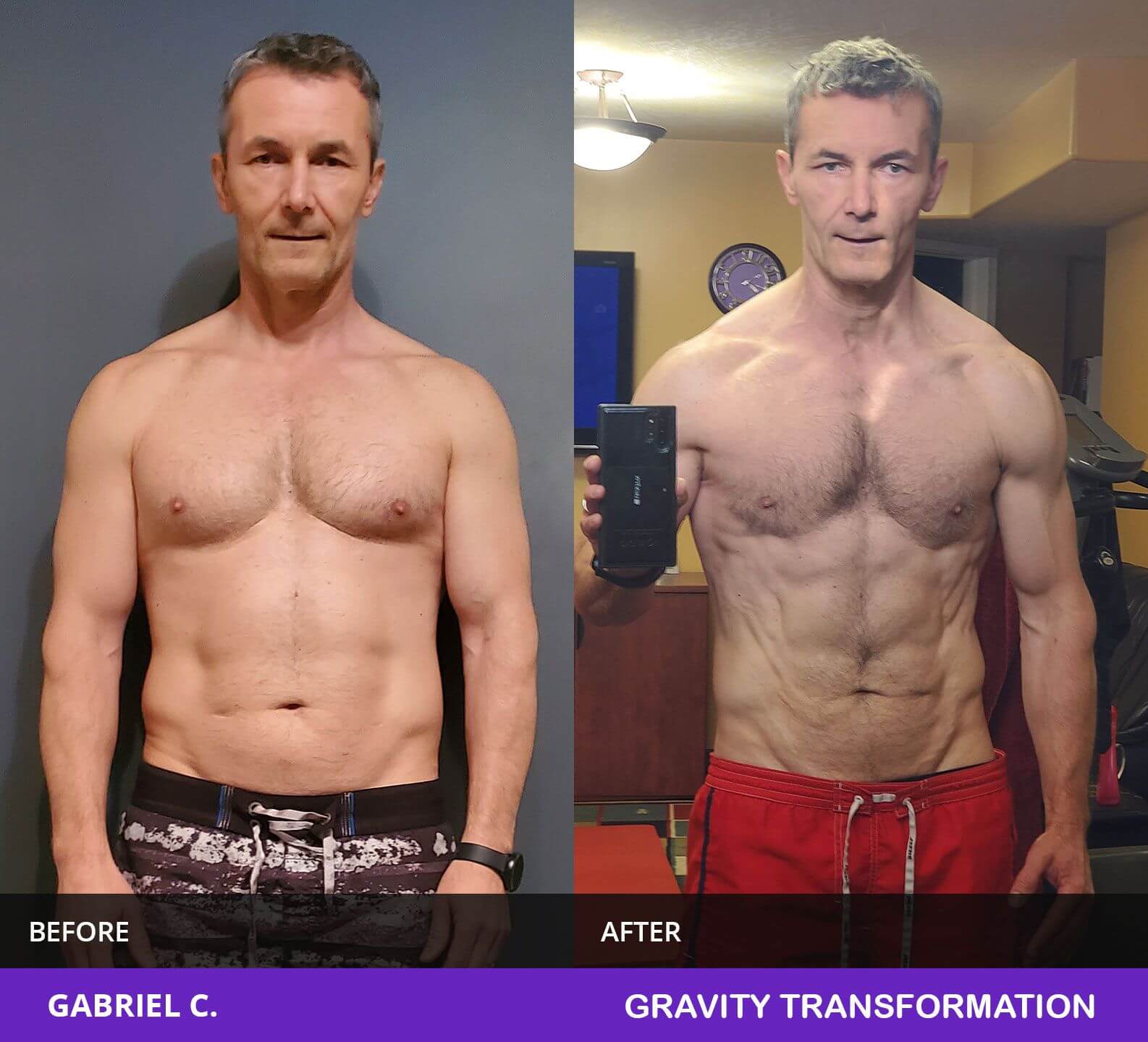
These 10 simple tips will make any workout better, regardless of whether you exercise at the gym or home.
This article will teach you the best things to do during every workout to see improved performance and better results.
You’ll also discover common workout mistakes to avoid and things that you should never do again at the gym.
What you do during your workout will determine how fast you build muscle, get stronger, and improve your body composition.
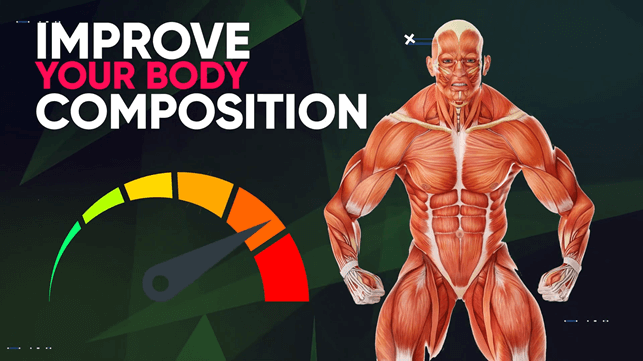
If you focus on the wrong things during your workout, you’ll slow down your progress and hit a plateau. Eventually, you’ll get demotivated.
That’s why today I want to go over 10 things that you should do during every single workout to get faster results.
#1 Listen to music
And the truth is we can talk about the structure of your workout all day. But if you’re not focused during your workouts, it’s going to be very difficult to push to the next level.
That’s why the first simple scientifically proven tip is to listen to your favorite music during every workout.
Many studies show that simply putting on some headphones and listening to your favorite songs can actually improve athletic performance.

Music can boost performance most likely in one of two ways – by either delaying fatigue onset or increasing work capacity.
According to a study by well-known sports psychologists, the effects of music lead to higher-than-expected levels of endurance, power, productivity, or strength. (1).
And many other studies point in this same direction and come to the same conclusion.
Specifically, research shows that music can increase strength endurance. And faster-paced motivational music has been shown to boost workout performance better than neutral or slower-paced music. (2)
For example, a study looked at the effect that music has on participants’ choice to ramp up treadmill speed.
While listening to faster-paced music, participants could increase their pace and distance traveled without becoming any more tired. (3)

Music doesn’t just increase energy and motivation. It can reduce fatigue most likely because it helps distract you from the pain that exercise is causing you.
And this fits very well with my personal experience. Some of my personal best strength gains have come right after creating a brand new playlist that would motivate me.
So if you’ve been listening to the same songs for months, now it’s time to look for new motivating music.
It makes a huge difference that’s hard to fully quantify in studies.
#2 Keep hydrated. Water only!
Something else that you’ll want to do is to drink water throughout your workout.
This will help you replace fluids that you lose through sweat, which has a beneficial effect on performance.
If you don’t sweat much during your workout this isn’t as important. But either way, don’t make the mistake of getting a sports drink full of sugar instead of water.
That’s because research doesn’t show much of a beneficial effect from intra-workout carbs consumption.

These are carbs that you take in specifically during your workout.
So unless you’re really low on carbs, it’ll only add extra sugar to your diet without improving performance.
So stick to water, especially when you’re sweating.
#3 Eliminate distractions
Another simple but very powerful tip to increase focus is to eliminate distractions during workouts.
Mostly this is done by putting your phone on silent and listening to a set playlist. This way you don’t have to keep checking your phone.
It’s very common for people to come into their workout ready to train hard. And then, when they go to check their phone for “just a minute”, an unexpected email or message pops up.
This leads to a significant delay between sets.
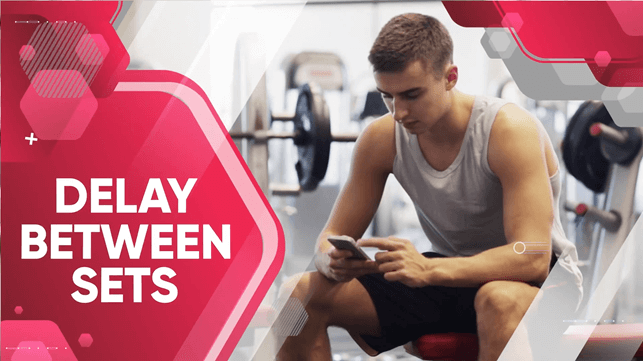
This doesn’t only mean that your workout will last much longer than necessary. These kinds of distractions also prevent you from reaching or staying in a flow state. It takes time to get back into it.
Again, if you’re not focused it doesn’t matter if you have the best workout routine in the world. You’re not going to give it your best, which is more important.
It’s no surprise that your phone can decrease focus. Research clearly shows that having a smartphone within reach can reduce available cognitive capacity. (4)
So set your phone to play your music and don’t check it until the end of your workout.
#4 Apply progressive overload
Something that you absolutely must do to see progress is to apply progressive overload.
This essentially means that you need to make your workout harder over time and continuously place more stress on your body than what it’s used to.
By doing that you give your muscles a reason to improve and develop.
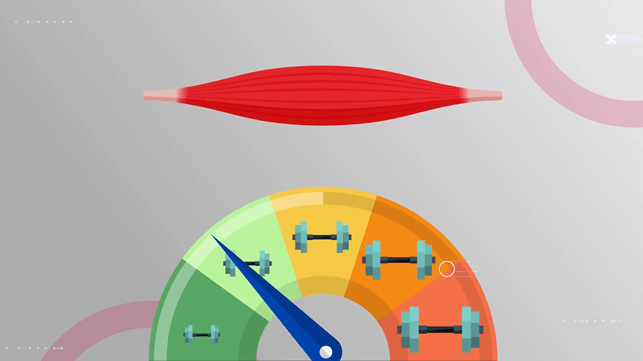
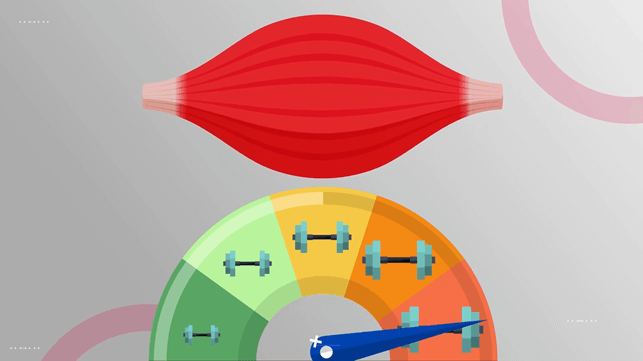
If you don’t do that, your body won’t waste precious energy on building and maintaining more metabolically expensive muscle. So you won’t see the results you were hoping for.
Now there are many ways you can apply progressive overload. For example, you can try to lift heavier weights over time.
Alternatively, you can keep the weight the same and increase the number of reps or sets per workout.
You can also keep reps, sets, and weight load the same, and simply decrease rest time between your sets.
Another way to achieve progressive overload would be to increase training frequency. For example, hit your legs three times a week instead of twice.
And there are other ways too, like increasing range of motion for your exercises, or reducing stability.
However, the most effective and straightforward way to apply progressive overload is to focus on getting stronger. Essentially, this is the key point of resistance training to begin with.
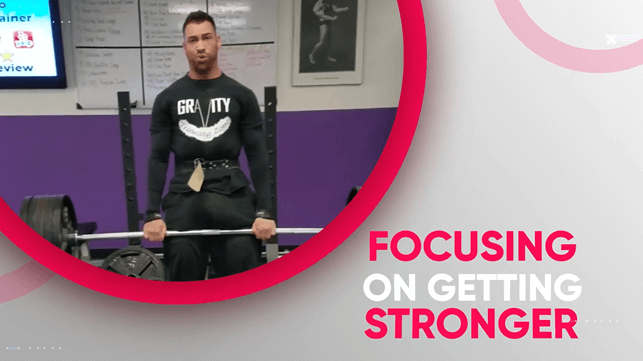
Science confirms that there’s a close relationship between strength and size.
Here’s an example from a study published in The Journal of Strength and Conditioning Research. Researchers found that the more weight participants could bench press, the more mass they would have on their pecs. (5)
Further evidence shows a strong relationship between body mass and performance in Olympic weightlifters. (6)
And this relationship is even more obvious in powerlifters, with an 86-95% correlation between the amount of fat-free mass (muscle mass) and the amount they’re able to lift. (7)
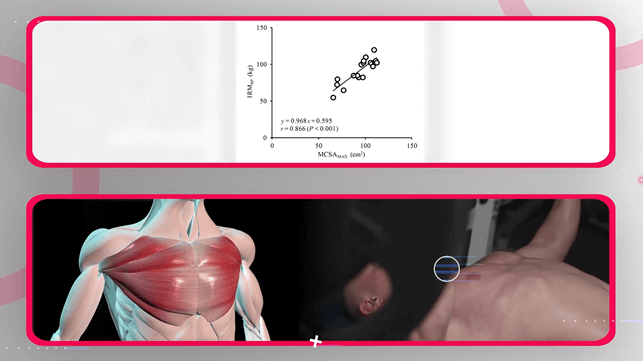
That’s close to a 100% correlation. So if you want to gain muscle, focus on getting stronger by simply increasing the weight you use over time.
Consistently adding a small amount of weight, like the 2½ pound plates, on each side of the bar every now and then will add up to big strength and size gains over time.
#5 Track your performance
Since progressive overload is so important, tracking your workout performance is another thing that you should do every workout.
Without tracking your progress, you won’t remember how much weight you used and how many reps you performed previously.
This goes for your last workout, let alone workouts that you performed weeks, months, or even years ago.

The main things to track are the exercises you did. You should include how much weight you used, and how many sets and reps you performed.
To keep it super simple you can track your performance with a notebook and a pen.
There are of course apps that you can use. But, again, we want to minimize phone distractions so a simple journal or notebook could work a lot better.
#6 Maintain good form. No Ego lifting.
While you’ll want to ensure progressive overload, it’s also important not to get sloppy. And to maintain good form during every workout.
In other words – no ego lifting. Don’t try to lift more weight than you actually can.
Keep in mind, most of the injuries that happen are preventable. That’s because they’re the result of ignoring proper form allowing the ego to take over.
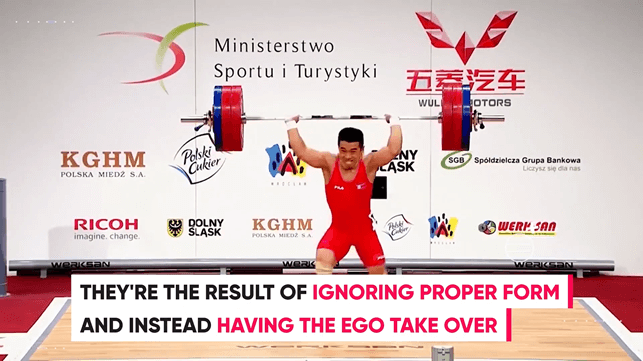
Ego lifting is a real problem, specifically for guys. Data shows that “as of 2019 more than half of all gym members are female (50.5%).” (8)
Yet, men are six times more likely to suffer a weightlifting injury compared to females. (9)
So, it might be tempting to increase the weight on the bar at all costs. But it’s not worth it if your form becomes compromised.
With that said you should also be struggling so your last 1-2 reps for every set may look a little sloppy. Because you’re pushing yourself through fatigue.
But if you’re performing quarter reps or rounding your spine during deadlifts, then you need to drop the weight. Work your way up with proper form.
#7 Go for the full range of motion
Speaking of quarter reps you’ll want to perform most exercises through a full Range of motion during every workout.
Research is clear on the fact that going through a full range of motion is better than partial. For example, one study had two groups perform the same bicep workouts for ten weeks. (10)
The only difference was that one group did partial reps and the other did full reps.
The participants in the full range of motion group ended up building more muscle on their biceps.

In a similar 8 week-long study the legs were tested with exercises like squats, lunges, and leg press. (11)
Again, the only difference between the groups was that one was performing partial reps while the other did full reps.
Once again participants that performed full reps gained much more muscle on their legs.
#8 No pain… no gain?
Another important thing that you should be doing during every workout is listening to your body.
You’ve probably heard the tagline “no pain, no gain“. And while it is true that you need to train hard to see results, that doesn’t mean you should ignore signals from your body.
In some workouts, a certain joint might feel achy or you might feel weaker than normal for a string of workouts.
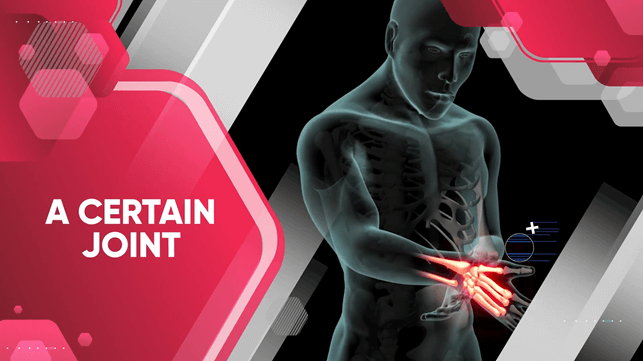
Those signals tend to happen for a reason. Often, it’s your body indicating that something is wrong, which is why you shouldn’t ignore it.
For example, let’s say your elbows hurt during skull crushers or your wrists hurt during barbell curls.
Even though you can try to train through that pain, it’s probably better to find an alternative pain-free exercise.
Believe it or not, it’s generally a bad idea to train through pain. Research indicates that listening to your body and avoiding pain is an effective strategy to autoregulate your training when injured. (12)
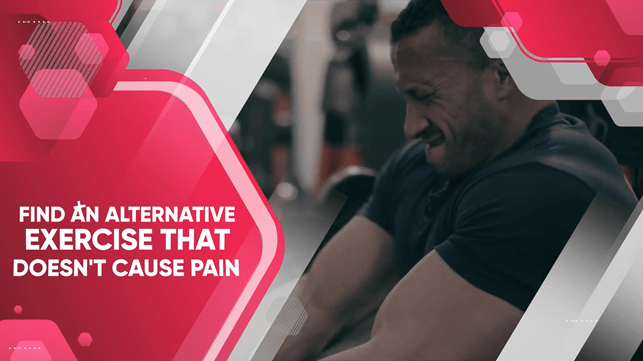
And even in some rare cases where training through pain can be beneficial for short-term recovery from an injury, it turns out that not training through pain provides similar long-term results according to a 2017 meta-analysis. (13)
So, not training through pain is safer, and doesn’t negatively affect results in the long run.
This is especially true for strength training injuries, as most strength training injuries are overuse injuries. (14).
Keep in mind I’m not saying to skip workouts. There’s almost always something else that you can do that doesn’t cause pain.
Even if you have a broken foot you can still work more on your upper body while your foot recovers.
#9 Optimize exercise order
Another important thing to do is to optimize the order of your exercises for each workout.
Meaning, not all exercises should be given the same level of priority.
The main reason for this is that you make better progress on exercises and muscle groups that you train first in a workout.
On the other hand, the muscles that you train later in the workout will progress at a slower rate. (15)
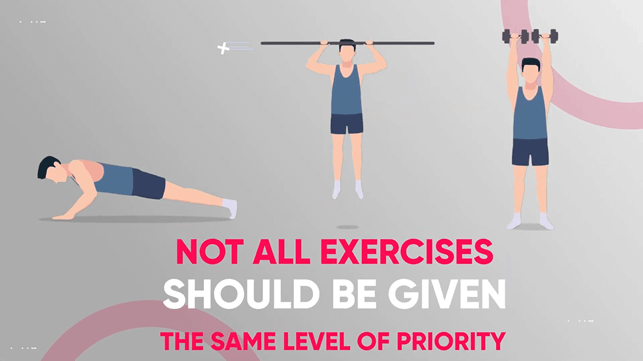
If you have a lagging muscle group, it’s helpful to position exercises targeting those muscles closer to the beginning.
Just keep two general rules of thumb in mind.
First, it’s better to perform your lower-rep heavier-weight exercises before you perform the higher-rep lighter-weight ones.
Doing higher-rep training before your heavy lifts hurt your performance on the heavier loads.
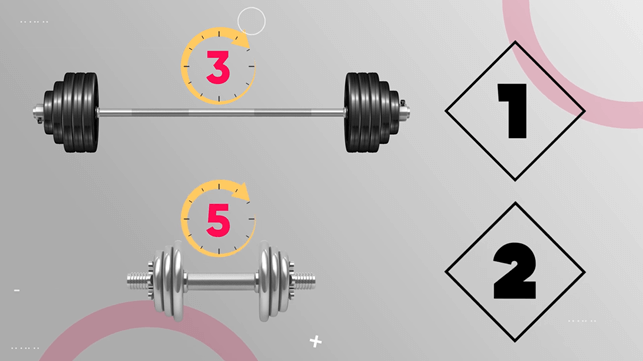
And you would think that the same would apply vice versa. But when you do heavy low-rep sets first and then perform higher-rep exercises it doesn’t negatively affect you as much.
Second, remember that it’s typically best to position your largest muscle groups, and compound exercises first. Then move on to the isolation exercises targeting the same muscle.
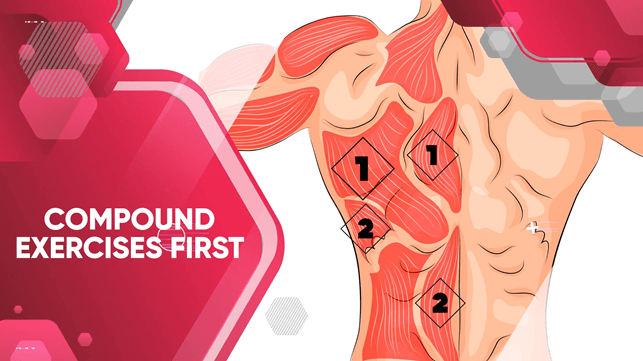
So, even if your goal is to build bigger biceps, if you do barbell rows on the same day, it’s best to position them before your bicep curls.
That’s because rows also recruit the very large muscles of your back in addition to the biceps. They also typically require much heavier weight loads. So it’s best to do them while you’re still fresh.
Pre-fatiguing a muscle with an isolation exercise creates a weak link during the compound movement, which reduces work capacity and muscle activation. (16)
#10 Warm-up
Moving on to the next one, you should take 5-10 minutes to perform a proper warm-up.
This will help you reduce your risk of injury and it’ll actually help boost performance. That’s because it improves flexibility, blood flow, oxygen availability, and nervous system speed and efficiency. (17)
Just make sure that you’re not relying on static or isometric stretches because they can reduce performance.
You might have been taught since you were a kid to do these kinds of stretches. However, a meta-analysis of over 360 studies didn’t find static stretching to prevent from injury risk. (18) (19)
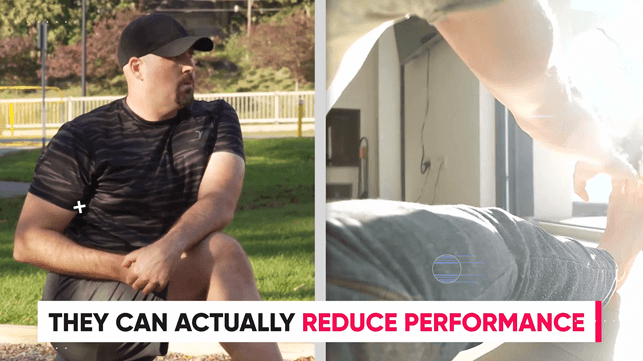
So instead of static stretching, Step 1 is to just raise your body temperature. You can do this by walking on a treadmill, doing some jumping jacks, or even getting into a sauna.
Raising your body temperature improves blood flow to your muscles, metabolic activity, muscle activation, and flexibility.
Step 2 isn’t mandatory, but you can include dynamic stretches. These are essentially active stretches that don’t impair strength, power, or endurance. (20)
An example is performing Frankenstein’s to warm up your hamstrings instead of a static sit and reach.
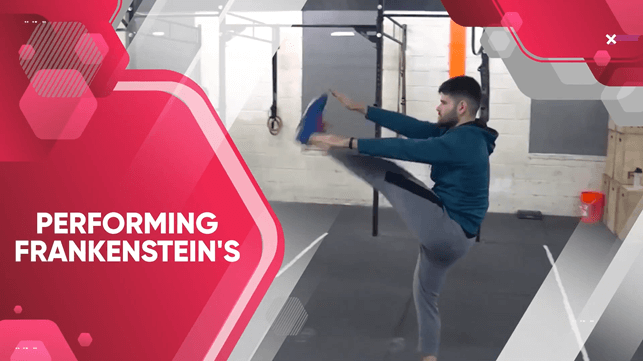
You don’t have to do dynamic stretches but definitely do step 3. That is – progressively perform warm-up sets specifically for the exercise that you start your workout with.
I recommend anywhere from three to five warm-up sets. The first set would be really light, for example using just the weight of the barbell itself.
And each warm-up set after that you should up the weight proportionally. The idea is to get closer to the weight load that you intend to lift for your actual sets.
Concluding notes
So those are 10 things you should do during every workout.
And keep in mind whether your main goal is fat loss or building muscle, you will need to adjust your diet and training regiment over time as things change.
So if you want to skip all that trial and error or if you just need any extra help, check out the link below.
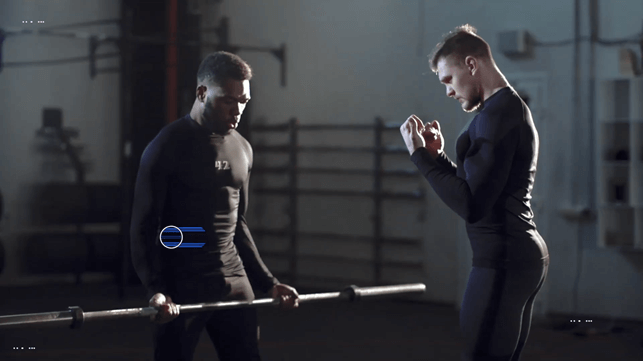
We have done-for-you programs that are helping my clients lose 20 pounds or 5 percent of their body fat in just 6 weeks.
There are also one-on-one coaching sessions available, and maintenance plans for longer-term goals.
To find out more click the link below.
References
- The effects of music lead to higher-than-expected levels of endurance, power, productivity, or strength.
https://psycnet.apa.org/record/2010-19053-016
- The ergogenic effects of motivational music exceeded those of oudeterous (neutral) music.
https://www.ncbi.nlm.nih.gov/pmc/articles/PMC3339577/
- Significant effects and interactions were found for running speed and heart rate across the different music tempo and loudness levels. More positive effect was observed during the music condition in comparison to the ‘no music’ condition.
https://pubmed.ncbi.nlm.nih.gov/17090506/
- Having a smartphone within reach can reduce available cognitive capacity.
https://www.journals.uchicago.edu/doi/10.1086/691462
- A study published in The Journal of Strength and Conditioning Research Demonstrates the relationship between chest size and bench press strength and finds a very close correlation
https://pubmed.ncbi.nlm.nih.gov/24169471/
- This isn’t the only study that found this. There’s also a strong relationship between body mass and performance in Olympic weightlifters.
https://pubmed.ncbi.nlm.nih.gov/10956351/
- “Performance of the SQT, BP, and DL strongly correlated with FFM and FFM relative to standing height. r = 0.86 to 0.95, P < or = 0.001.”
https://pubmed.ncbi.nlm.nih.gov/11990746/
- “As of 2019 more than half of all gym members were female (50.5%).”
https://runrepeat.com/gym-membership-statistics
- “an approximate 6:1 disparity in weightlifting injuries prevalence was observed between males and females from this sample.”
https://www.ncbi.nlm.nih.gov/pmc/articles/PMC2770173/
- one study divided thirty young men without resistance training experience into two groups.
https://pubmed.ncbi.nlm.nih.gov/22027847/
- In another study, sixteen recreationally active men and women followed an eight-week leg training program.
https://pubmed.ncbi.nlm.nih.gov/23629583/
- Also, it’s generally a bad idea to train through pain. Research indicates that listening to your body and avoiding pain is a very good way to autoregulate your training when you’re injured.
https://pubmed.ncbi.nlm.nih.gov/15564907/
https://link.springer.com/article/10.1007/s40279-016-0667-x
https://www.minervamedica.it/en/journals/sports-med-physical-fitness/index.php
- Not training through pain provides similar long-term results according to a 2017 meta-analysis.
https://pubmed.ncbi.nlm.nih.gov/28596288/
- So, not training through pain is safer. This is especially true for strength training injuries, as most strength training injuries by far are overuse injuries.
https://link.springer.com/article/10.1007/s40279-016-0575-0
https://www.ncbi.nlm.nih.gov/pmc/articles/PMC6059276/
- You make better progress on exercises and muscle groups you train first in a workout. Whereas you see fewer results among the movements and muscles you train later.
https://pubmed.ncbi.nlm.nih.gov/20938358/
- Pre-fatiguing a muscle with an isolation exercise induces a weak link during the compound movement, which reduces work capacity and muscle activation.
https://pubmed.ncbi.nlm.nih.gov/16503673/
https://pubmed.ncbi.nlm.nih.gov/23487480/
https://pubmed.ncbi.nlm.nih.gov/12741886/
- Warming up improves flexibility, blood flow, oxygen availability, and nervous system speed and efficiency
https://pubmed.ncbi.nlm.nih.gov/3849057/
- However, don’t rely on static stretches. Such stretches before exercising do not reduce injury risk, as found by a meta-analysis of 361 studies.
https://pubmed.ncbi.nlm.nih.gov/15076777/
- “there is not sufficient evidence to endorse or discontinue routine stretching before or after exercise to prevent injury among competitive or recreational athletes.”
https://pubmed.ncbi.nlm.nih.gov/15076777/
- Contrary to static stretches, dynamic ones don’t impair strength, power, or muscular endurance, but they may even increase it.
My passion for fitness began when I was 14 years old. I naturally fell in love with training and haven’t stopped since. At 18 years I acquired my first personal training certification from ACE after which I opened my first of 3 transformation studios in 2011. I love to share my knowledge through personal training, my online courses, and youtube channel now with over 3,000,000 subscribers! I can happily say that we've helped over 15,000 people get in great shape over the years. I'm always here for my customers so if you need help don't hesitate to send your questions to support@gravitychallenges.com

